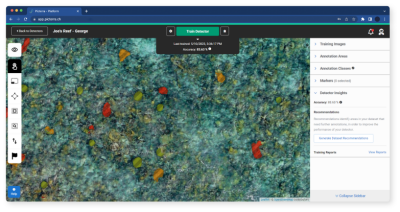One of my favorite shows to watch lately with the kids is Blue Planet, what has to be the best television production ever to focus on the world’s underwater life. To say I learn something with every show is an understatement. Last week, we watched their episode on coral reefs, and I was more than a little fascinated (did you know coral actually attacks other coral that infringes on its territory, using this crazy acid attack?). But also disheartened. Rising sea levels and water temperatures are causing widespread bleaching events and as much as 16 percent of all coral on the planet can be lost in a single year.
So, I’m glad the USGS is working with the National Parks Service to keep track of these sorts of things and work to slow coral loss (among other environmental efforts). One of the problems with mapping shallow water is that the water is often too deep for bathymetry and too shallow for vessels with multi-beam sonar to safely navigate (safe for the coral and the vessels, both).
Over the past decade, however, the USGS, Marine Geology Program, and NASA have been collaborating on ways to solve this problem. An article posted not long ago documents those efforts. Essentially, with the Experimental Advanced Airborne Lidar system, plus some innovative processing techniques, researchers are able to use lidar to gather both normal terrestrial data and submerged terrain data in the same flyover, making the data acquisition much more efficient.
Operating in the blue-green portion of the electromagnetic spectrum, the EAARL is specifically designed to measure submerged topography and adjacent coastal land elevations seamlessly in a single scan of transmitted laser pulses.
Further, they’re able to get deeper than you might think – up to 20 meters deep. This allows the National Parks to quickly inventory and observe big swaths of coral reefs:
One objective of the USGS-NPS collaborative research is to create techniques to survey coral reefs for the purposes of habitat mapping, ecological monitoring, change detection, and event assessment (for example: bleaching, hurricanes, and disease outbreaks).
Plus, they can map beach erosion, vegetation growth and encroachment, and all kinds of other things that need monitoring on the land side. It’s pretty easy to see how this data would be hugely valuable in efforts to maintain some of the United States’ most precious and spectacular environments.
It’s not easy, though. It’s not like you can just hand over the lidar data to researchers. Currently, the process involves taking the lidar data and running it through a specially designed conversion process called ALPS to create GIS-compatible map products. That means exporting as ASCII, then converting using GEOID03 and creating 2 km x 2 km GeoTIFF map tiles. This seems laborious and processor-time consuming.
I think it’s incumbent, going forward, that we create quicker paths from lidar to useful information that the managers of these habitats can use to make better care-taking decisions. That won’t be easy, either, but I’ve seen the coral reefs in person, as well, and it’s certainly worth the effort.





